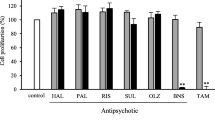Abstract
To determine whether atypical antipsychotics, when compared to typical antipsychotics, increase the risk of breast cancer. We conducted a retrospective cohort study using a nested case–control analysis within the United Kingdom General Practice Research Database population. We identified all female patients prescribed at least one antipsychotic (either typical or atypical), between 1 January 1988 and 31 December 2007, with follow-up until 31 December 2010. All incident cases of breast cancer were identified and matched up to 10 controls. Adjusted rate ratios (RR) of breast cancer associated with ever use of atypical antipsychotics was compared to ever use of typical antipsychotics. The cohort included 106,362 patients prescribed antipsychotics during the study period. During a mean follow-up of 5.3 years, 1237 patients were diagnosed with breast cancer (overall rate: 2.7 per 1000/year). Compared to patients who only used typical antipsychotics, exclusive users of atypical antipsychotics were not an increased risk of breast cancer (RR: 0.81, 95% CI: 0.63, 1.05). These results remained consistent after considering specific atypical antipsychotics known to significantly increase prolactin levels such as risperidone (RR: 0.86, 95% CI: 0.60, 1.25). Furthermore, no dose–response was observed in terms of cumulative duration of use and cumulative dose in olanzapine equivalents. The results of this study should provide reassurance that compared to typical antipsychotics, atypical antipsychotics do not increase the risk of breast cancer.


Similar content being viewed by others
References
Alessi-Severini S, Biscontri RG, Collins DM, Kozyrskyj A, Sareen J et al (2008) Utilization and costs of antipsychotic agents: a Canadian population-based study, 1996–2006. Psychiatr Serv 59:547–553
Leslie DL, Mohamed S, Rosenheck RA (2009) Off-label use of antipsychotic medications in the department of Veterans Affairs health care system. Psychiatr Serv 60:1175–1181
Allison DB, Mentore JL, Heo M, Chandler LP, Cappelleri JC et al (1999) Antipsychotic-induced weight gain: a comprehensive research synthesis. Am J Psychiatry 156:1686–1696
Bostwick JR, Guthrie SK, Ellingrod VL (2009) Antipsychotic-induced hyperprolactinemia. Pharmacotherapy 29:64–73
Miller CH, Mohr F, Umbricht D, Woerner M, Fleischhacker WW et al (1998) The prevalence of acute extrapyramidal signs and symptoms in patients treated with clozapine, risperidone, and conventional antipsychotics. J Clin Psychiatry 59:69–75
Wang PS, Walker AM, Tsuang MT, Orav EJ, Glynn RJ et al (2002) Dopamine antagonists and the development of breast cancer. Arch Gen Psychiatry 59:1147–1154
Haddad PM, Wieck A (2004) Antipsychotic-induced hyperprolactinaemia: mechanisms, clinical features and management. Drugs 64:2291–2314
Seeman P (2002) Atypical antipsychotics: mechanism of action. Can J Psychiatry 47:27–38
Bushe C, Shaw M, Peveler RC (2008) A review of the association between antipsychotic use and hyperprolactinaemia. J Psychopharmacol 22:46–55
Overall JE (1978) Prior psychiatric treatment and the development of breast cancer. Arch Gen Psychiatry 35:898–899
Wagner S, Mantel N (1978) Breast cancer at a psychiatric hospital before and after the introduction of neuroleptic agents. Cancer Res 38:2703–2708
Kelly JP, Rosenberg L, Palmer JR, Rao RS, Strom BL et al (1999) Risk of breast cancer according to use of antidepressants, phenothiazines, and antihistamines. Am J Epidemiol 150:861–868
Dalton SO, Johansen C, Poulsen AH, Norgaard M, Sorensen HT et al (2006) Cancer risk among users of neuroleptic medication: a population-based cohort study. Br J Cancer 95:934–939
Hippisley-Cox J, Vinogradova Y, Coupland C, Parker C (2007) Risk of malignancy in patients with schizophrenia or bipolar disorder: nested case-control study. Arch Gen Psychiatry 64:1368–1376
Walley T, Mantgani A (1997) The UK General Practice Research Database. Lancet 350:1097–1099
Garcia Rodriguez LA, Perez GS (1998) Use of the UK General Practice Research Database for pharmacoepidemiology. Br J Clin Pharmacol 45:419–425
Jick H, Jick SS, Derby LE (1991) Validation of information recorded on general practitioner based computerised data resource in the United Kingdom. BMJ 302:766–768
Lawrenson R, Williams T, Farmer R (1999) Clinical information for research; the use of general practice databases. J Public Health Med 21:299–304
Lawrenson R, Todd JC, Leydon GM, Williams TJ, Farmer RD (2000) Validation of the diagnosis of venous thromboembolism in general practice database studies. Br J Clin Pharmacol 49:591–596
Jick SS, Kaye JA, Vasilakis-Scaramozza C, Garcia Rodriguez LA, Ruigomez A et al (2003) Validity of the general practice research database. Pharmacotherapy 23:686–689
Opatrny L, Dell’Aniello S, Assouline S, Suissa S (2008) Hormone replacement therapy use and variations in the risk of breast cancer. BJOG 115:169–175
Gardner DM, Murphy AL, O’Donnell H, Centorrino F, Baldessarini RJ (2010) International consensus study of antipsychotic dosing. Am J Psychiatry 167:686–693
Hankinson SE, Willett WC, Michaud DS, Manson JE, Colditz GA et al (1999) Plasma prolactin levels and subsequent risk of breast cancer in postmenopausal women. J Natl Cancer Inst 91:629–634
Tworoger SS, Eliassen AH, Rosner B, Sluss P, Hankinson SE (2004) Plasma prolactin concentrations and risk of postmenopausal breast cancer. Cancer Res 64:6814–6819
Tworoger SS, Sluss P, Hankinson SE (2006) Association between plasma prolactin concentrations and risk of breast cancer among predominately premenopausal women. Cancer Res 66:2476–2482
Tworoger SS, Hankinson SE (2008) Prolactin and breast cancer etiology: an epidemiologic perspective. J Mammary Gland Biol Neoplasia 13:41–53
Lieberman JA, Stroup TS, McEvoy JP, Swartz MS, Rosenheck RA et al (2005) Effectiveness of antipsychotic drugs in patients with chronic schizophrenia. N Engl J Med 353:1209–1223
Rosenheck R, Perlick D, Bingham S, Liu-Mares W, Collins J et al (2003) Effectiveness and cost of olanzapine and haloperidol in the treatment of schizophrenia: a randomized controlled trial. JAMA 290:2693–2702
Acknowledgments
Dr. Laurent Azoulay is the recipient of a ‘Chercheur-Boursier’ Award from the Fonds de la recherche en santé du Québec. Dr. Samy Suissa is the recipient of a Distinguished Investigator Award from the Canadian Institutes of Health Research. This study was supported by a Catalyst Grant from the Canadian Institutes of Health Research.
Conflicts of interest
The authors report no conflicts of interest.
Author information
Authors and Affiliations
Corresponding author
Rights and permissions
About this article
Cite this article
Azoulay, L., Yin, H., Renoux, C. et al. The use of atypical antipsychotics and the risk of breast cancer. Breast Cancer Res Treat 129, 541–548 (2011). https://doi.org/10.1007/s10549-011-1506-2
Received:
Accepted:
Published:
Issue Date:
DOI: https://doi.org/10.1007/s10549-011-1506-2




